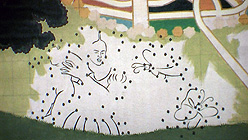Chicago-based artist Kerry James Marshall’s large-scale artworks participate in the tradition of history painting — larger-than-life depictions of historical events. But whereas traditionally, history paintings have often relayed official accounts of nationhood, Marshall uses his work to bring untold history and counter-histories to light. Spark visits with Marshall as he works with San Francisco’s Precita Eyes muralists in creating Visible Means of Support, two specially commissioned murals for SFMOMA’s Haas Atrium.
Marshall’s sense of social responsibility guides his depictions of African American figures often absent in art institutions. His museum pieces place African Americans front and center in an array of situations that range from idyllic romantic scenarios to scenes of leaders from key historical events, like the Civil Rights Movement. The idea is to present African Americans in the full range of human experience.
Often emphatically depicted in deep shades of black, Marshall’s figures stand in stark contrast to their surroundings. These renderings have been controversial for some, but for Marshall, the decision to portray his figures in this manner is both aesthetic and political. Their absolute blackness lends a pictorial power that demands the viewer pay attention to them.
In this sense, the two murals at SFMOMA are a departure from Marshall’s usual style. The two enormous panels, each measuring 27 by 32 feet, represent what on the surface appear to be standard depictions of American history: Mount Vernon and Monticello, the estates of George Washington and Thomas Jefferson, respectively. Marshall’s usual strategy of dramatically announcing his African American figures is missing from these murals. At first glance, the large anamorphic renderings of Washington and Jefferson are the only figures one sees.
Upon closer examination, it becomes clear that Marshall has employed visual trickery to embed a series of figures in the scene — images of the African American slaves that supported these plantations. They aren’t apparent immediately, but as one looks more closely, they emerge everywhere: in the trees, the sky, the flowers, the fields, the water, and even subtler, more hidden places: In one section, Marshall has included connect-the-dot images that form African American figures, and even the dots themselves are small icons of African American heads.
To accomplish this optical trickery, Marshall has borrowed a visual language from preschool activity books — at once universally recognized and entirely unusual for history painting. The flat, un-modulated colors and heavy outlines suggest children’s coloring books, as do the connect-the-dot figures and hidden imagery that populate the murals. It’s an invitation with a simple message: Engage with this history — it’s open, it’s not difficult, it can even be fun.
Kerry James Marshall was educated at the Otis Art Institute in Los Angeles, where he earned a B.F.A. In 1999, the institute awarded him an honorary doctorate. Marshall has shown his work at several international venues, including the 2007 and 1997 editions of Documenta, the 2003 Venice Biennale, the 1999/2000 Carnegie International and the 1997 Whitney Biennial. Among the many honors he has received are a MacArthur Fellowship, a National Endowment for the Arts Visual Arts Fellowship, a Wexner Center Residency Award and a Skowhegan Medal for Painting. Marshall’s work is represented in major private and museum collections throughout the world, including the Koplin del Rio Gallery, Culver City; the Jack Shainman Gallery, New York City; the Los Angeles County Museum of Art; the Museum of Modern Art, New York City; the Walker Art Center, Minneapolis; and the Whitney Museum of American Art, New York.
Array
Resources
- Array
- Array
- Array
Related Episodes
Marshall, Hoyle, and LEVYdance
Meet a renowned painter, a monologist who's a chip off the old block, and choreographer exploring family history.

